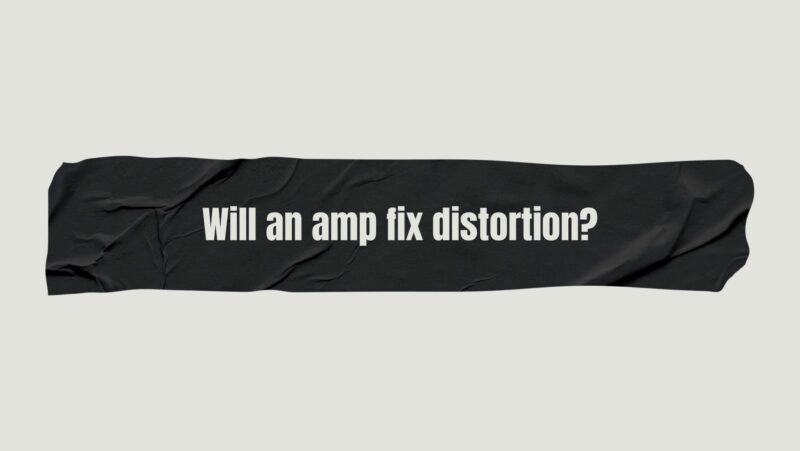Audio distortion is a common concern that plagues the world of audio enthusiasts and casual listeners alike. Whether it’s due to poor source quality, inadequate equipment, or various other factors, distortion can significantly hinder the enjoyment of music and sound. As individuals seek solutions to alleviate audio distortion, one question frequently arises: can an amplifier fix distortion? This article delves into the complex relationship between amplifiers and distortion, explores the types of distortion that can occur, and provides insights into how amplifiers can play a role in addressing distortion issues.
Understanding Audio Distortion
Audio distortion refers to any alteration or deviation from the original audio signal. It can manifest in various forms, such as harmonic distortion, intermodulation distortion, and clipping. Distortion can stem from issues within the source material, the playback equipment, or even the listening environment.
The Role of Amplifiers
Amplifiers are essential components of audio systems, responsible for boosting the weak electrical signals from audio sources to levels suitable for driving speakers. Their primary goal is to accurately reproduce the audio signal without introducing distortion of their own. However, the relationship between amplifiers and distortion is more nuanced than a straightforward fix.
Types of Distortion
- Harmonic Distortion: Harmonic distortion occurs when the amplifier introduces additional harmonics, or frequency components, that were not present in the original signal. While amplifiers can contribute to harmonic distortion, they are not inherently a solution for this type of distortion.
- Intermodulation Distortion: Intermodulation distortion occurs when two or more frequencies interact within the amplifier, creating sum and difference frequencies that were not part of the original audio signal.
- Clipping: Clipping distortion occurs when the amplifier’s output voltage exceeds its maximum capabilities. This can cause the peaks of the audio signal to be “clipped,” resulting in a flattened waveform and audible distortion.
Amplifier and Distortion Interaction
- Clean Amplification: High-quality amplifiers are designed to minimize distortion and accurately reproduce the input signal. They aim to prevent introducing additional distortion to the audio chain.
- Avoiding Amplifier-Induced Distortion: Selecting amplifiers with low distortion specifications and high signal-to-noise ratios helps minimize the contribution of the amplifier to overall distortion.
Addressing Distortion Causes
- Source Quality: Distortion originating from the source material itself cannot be rectified solely by an amplifier. Improving source quality through better recordings or higher-quality audio files is essential.
- Room Acoustics: Distortion can be influenced by the acoustic characteristics of the listening environment. Treating the room acoustics can contribute to a more accurate and distortion-free listening experience.
Matching Amplification to Speakers
- Sensitivity and Impedance: Choosing amplifiers that match the sensitivity and impedance of the connected speakers helps prevent distortion caused by impedance mismatch.
- Overdriving Speakers: Amplifiers that provide sufficient power to speakers help avoid distortion resulting from overdriving the speakers beyond their capabilities.
Balancing Amplifier Quality and Distortion
- Higher-Quality Amplifiers: Investing in high-quality amplifiers with low distortion and clean signal reproduction can significantly reduce the risk of introducing additional distortion to the audio signal.
- Amplifier Specifications: Paying attention to amplifier specifications, including total harmonic distortion (THD) and signal-to-noise ratio (SNR), aids in selecting equipment that minimizes distortion.
Practical Approaches to Reducing Distortion
- Quality of Source Material: Ensuring that source material is of high quality and properly encoded helps minimize distortion at the source.
- Proper Gain Staging: Properly setting gain levels across the audio chain prevents signal clipping and distortion, especially in recording and playback scenarios.
Conclusion
While amplifiers play a crucial role in audio systems by boosting weak signals and driving speakers, their ability to fix distortion depends on various factors. Amplifiers themselves can introduce distortion if they are of poor quality or not matched properly to the speakers. However, higher-quality amplifiers with accurate signal reproduction can minimize distortion caused by amplification. Addressing distortion requires a holistic approach that encompasses source quality, equipment specifications, room acoustics, and proper gain staging. By selecting quality amplification, ensuring proper gain levels, and optimizing the listening environment, individuals can achieve an audio experience that remains faithful to the original source and minimizes the negative effects of distortion.


